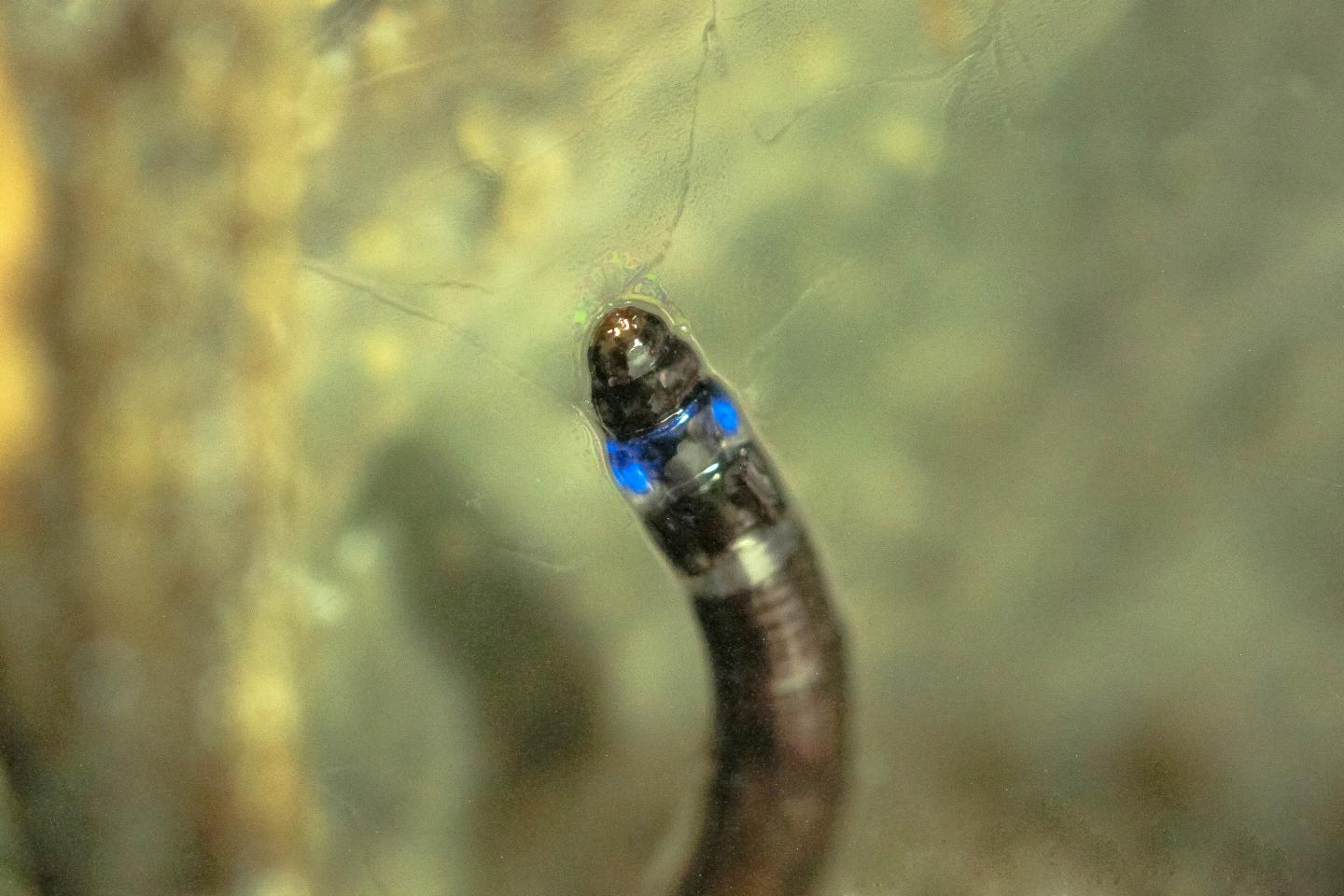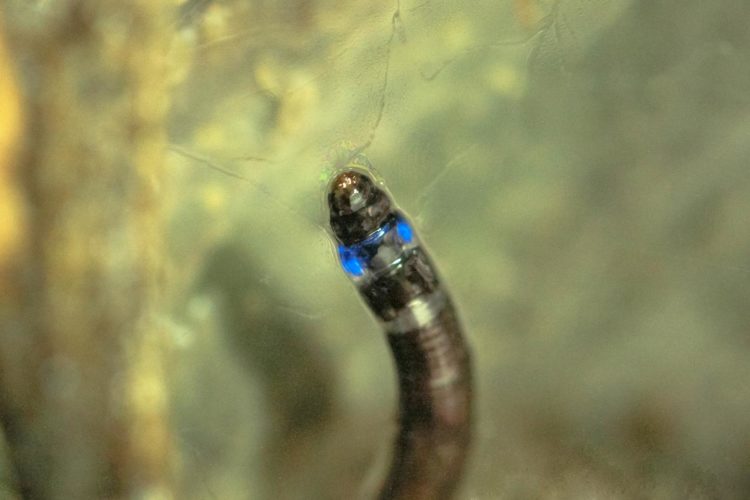Larvae of a fungus gnat found in Iporanga, São Paulo State, Brazil, have bioluminescent properties previously observed only in species native to North America, New Zealand and Asia; this study paves the way for new biotech applications

Credit: Henrique Domingos / IPBio
Brazilian researchers have discovered a new species of fungus gnat (Keroplatidae) whose larvae emit blue light. The small fly inhabits an Atlantic Rainforest reserve in São Paulo State. This is the first record of a blue bioluminescent species in the Neotropics. Many bioluminescent insects and fungi have been studied in the region, but all emit green, yellow or red light. The new species has been named Neoceroplatus betaryiensis and is described in an article in Scientific Reports.
“The larvae were found while bioluminescent mushrooms were being collected and drew attention because they emitted blue light. Fungi and fireflies don’t emit blue light, so it had to be a new species,” Cassius Stevani, a professor at the University of São Paulo’s Institute of Chemistry (IQ-USP) and last author of the article, told.
The study was part of the Thematic Project “Electronic chemiexcitation in biological systems: bioluminescence and photochemistry in the dark”, for which Etelvino José Henriques Bechara, a professor at IQ-USP, is principal investigator.
According to Stevani, species that emit blue light had previously been found only in North America, New Zealand and Asia. This one was found in Reserva Betary, a privately held Atlantic Rainforest reserve in Iporanga, São Paulo State, bordering the Upper Ribeira State Tourist Park (PETAR).
Biologists Isaias Santos and Grant Johnson, a US-born technical trainee with a scholarship from São Paulo Research Foundation – FAPESP, participated in the collection expedition. Both work at the Biodiversity Research Institute (IPBio), a nongovernmental organization that runs Reserva Betary, offering tourism, environmental education and research opportunities there. Many of the world’s species of bioluminescent mushrooms can be found on the property.
The new species of bioluminescent insect was described by entomologist Rafaela Falaschi, currently a postdoctoral researcher at the University of Ponta Grossa (UEPG). The species epithet (betaryiensis) refers to the Betary, a tributary of the Ribeira.
Different light patterns
According to Stevani, adults of the species do not emit light. The bioluminescent larvae live hidden in tree trunks and have three lanterns, one in the tail and two near the eyes.
However, one of the specimens collected by the researchers emitted light at various points on its body. The larva was taken to the laboratory, where it pupated. The pupa remained bioluminescent, but a wasp emerged instead of a fungus gnat.
The researchers concluded that the wasp also belongs to a new species in the parasitoid family Ichneumonidae, which lay eggs in the larvae of beetles, moths and other insects. It is unclear, however, if the different pattern of light emission observed in the specimen is due to an infection caused by the wasp, if it indicates a new species of gnat, or if the pattern is related to sexual dimorphism in N. betaryiensis (different morphological traits in males and females).
New system
In addition to the importance of any new species to the production of knowledge about biodiversity, insects that emit blue light are extremely rare, and the discovery suggests the possibility of unearthing a new system of bioluminescence that could have applications in analysis and biotechnology, such as in marking specific cells or genes in biological studies or pollution biosensors, for example.
Like all bioluminescent organisms, the new species generates light via a reaction between luciferin, a substrate, and luciferase, an enzyme that catalyzes it. In assays performed to study the phenomenon, the two compounds are typically isolated by producing an extract of the insect and separating it into portions. One is stored on ice to preserve its enzymes, including luciferase. The other is heated to eliminate the enzymes and leave only the substrate luciferin.
To begin characterizing the bioluminescent system in N. betaryiensis, the research group led by Vadim Viviani, a professor at the Federal University of São Carlos (UFSCar) in Sorocaba, São Paulo State, used luciferin and luciferase purified in their laboratory from another species capable of emitting blue light, Orfelia fultoni, which inhabits the Appalachian Mountains in the US and Canada.
“Thanks to having luciferase and luciferin from O. fultoni already purified in our lab, we were able to analyze cross-reactions with the new species. Light was emitted in all combinations. We also show that larvae of this fungus gnat contain a luciferin-storing protein known as SBF, which is short for substrate-binding fraction, as does O. fultoni. Therefore, both species have the same biochemical system,” said Viviani, who leads a research group on bioluminescence and biophotonics funded by the National Council for Scientific and Technological Development (CNPq), a federal government agency.
Next steps
In 2000, Viviani and researchers Thérèse Wilson and J. Woodland Hastings produced the first characterization of O. fultoni‘s bioluminescent system while Viviani was a postdoctoral fellow at Harvard University in the US. Since then, he has worked steadily on the biochemical characterization of luciferin and luciferase in these insects.
Viviani is the principal investigator for the Thematic Project “Arthropod bioluminescence” funded by FAPESP. His group recently discovered a species of the genus Neoditomyia in the caves of Intervales State Park, an Atlantic Rainforest remnant in the south of São Paulo State. This species produces luciferin and its SBF but does not emit light. When the substrate was blended with luciferase from O. fultoni and the new species, however, it emitted blue light (read more at agencia.fapesp.br/29066).
Genetic analysis also shows that the new species is closely related to Neoditomyia and O. fultoni.
Based on their knowledge of other species, the researchers now plan to isolate and investigate the luciferin and luciferase produced by N. betaryiensis, which is rarer and less easily found than the North American species.
“We already have luciferin and luciferase from O. fultoni, the North American species, and from the Neoditomyia found in Intervales. They have been purified and partially characterized by our lab at UFSCar. This enabled us to conduct this initial study and will also facilitate the isolation of luciferin and cloning of luciferase from Neoceroplatus in the future,” Viviani said.
Once isolated, the substances will be cloned, and their structure will be determined. The group at UFSCar will work on the luciferase, and Stevani’s group at IQ-USP will be responsible for analyzing the luciferin.
“We already have the molecular formula for luciferin. We know how many atoms of carbon, hydrogen, nitrogen, oxygen, sulfur and other elements it contains, but we don’t know how these atoms are linked. We need to perform experiments using nuclear magnetic resonance imaging, among other techniques, in order to elucidate the structure. I expect that to happen soon,” said Stevani, who is principal investigator of a research project on bioluminescent mushrooms funded by FAPESP.
###
About São Paulo Research Foundation (FAPESP)
The São Paulo Research Foundation (FAPESP) is a public institution with the mission of supporting scientific research in all fields of knowledge by awarding scholarships, fellowships and grants to investigators linked with higher education and research institutions in the State of São Paulo, Brazil. FAPESP is aware that the very best research can only be done by working with the best researchers internationally. Therefore, it has established partnerships with funding agencies, higher education, private companies, and research organizations in other countries known for the quality of their research and has been encouraging scientists funded by its grants to further develop their international collaboration. You can learn more about FAPESP at http://www.
Media Contact
Joao Carlos Silva
[email protected]
55-113-838-4381
Original Source
http://agencia.
Related Journal Article
http://dx.





